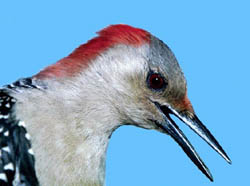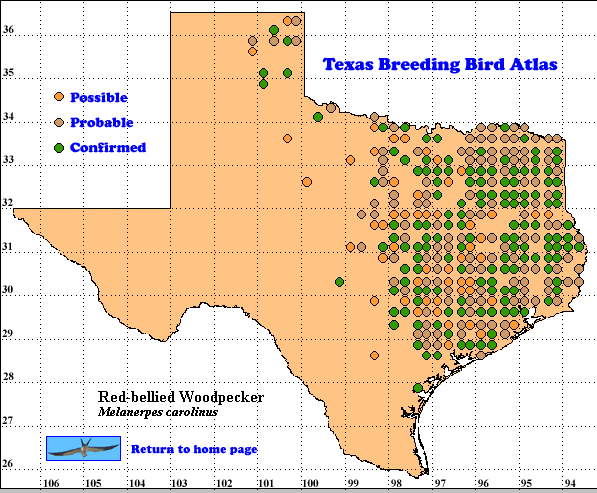Melanerpes carolinus
INTRODUCTION: The Red-bellied Woodpecker is the most common and conspicuous species of woodpecker in the eastern half of Texas (Oberholser 1974, T.O.S. 1995). The common name of this woodpecker is not well-appreciated since the red belly is not an obvious field mark, even when equipped with binoculars, as its small pale-red patch of belly feathers is usually flush to the tree. However, early ornithologists who were equipped with shotguns, noticed its unique red belly, hence its name. It is best identified by its black and white zebra-patterned back and red strip on the top of the head. There is more red on the male where the red nape patch (like on the female) extends anteriorly through the crown and to the beak like a punk-rocker with a red Mohawk haircut.
DISTRIBUTION: TBBAP data show that this woodpecker is truly an eastern breeding species occurring regularly as far west as the 100th meridian in central Texas, but further west in the Panhandle of Texas to Hutchison Co. The Red-bellied Woodpecker bred west locally to San Angelo in the 19th century (Oberholser 1974). In southern Texas, the Nueces River bottom provides a final area of preferred habitat before the mesquite (Prosopis glandulosa) brushlands act as a barrier to this species that does not tolerate these more arid woodlands. These mesquite brushlands, which form this boundary to the south and to the west of the Red-bellied Woodpeckers range, are occupied by its close relative, the Golden-fronted Woodpecker (M. aurifrons). These two species are sympatric in a very narrow strip that extends from central Texas north to southwestern Oklahoma (Selander and Giller 1959) where they occasionally hybridize (Smith 1987).
SEASONAL OCCURRENCE: In the eastern half of Texas, the Red-bellied Woodpecker is a resident species of moist woodlands, either deciduous, coniferous, or both (Bent 1964). In eastern Texas, Shackelford (1994) found Red-bellied Woodpeckers to be the most abundant woodpecker; here, more individuals were detected during fall and more occurred in hardwood-dominated forests than pine-dominated forests where a mix of pine and hardwood was studied. Some individuals in Texas are known to wander west during the winter, but most individuals maintain a year-round territory (Oberholser 1974). The TBBAP found 745 records of breeding activity in Texas, of which 27% were confirmed, 42% were probable, and 30% were possible breeding records.
BREEDING HABITAT: The nest is placed in soft wood on an inclined limb or trunk with the opening on the underside to prevent water from entering the cavity (Boone 1960). Nest predation was noted by Stickel (1962) by the black rat snake (Elaphe o. obsoleta). Breeding pairs are very territorial during spring and summer, and intraspecific territorial conflicts are common (Boone 1960). Pairs also quickly respond to the tape recorded calls by approaching to the sourceof the call (personal observations). Mutual tapping, simultaneous drumming of the pair perched in close proximity, may strengthen the pair-bond (Kilham 1958). Reverse mounting (female atop male) is not unusual in this species and its purpose cannot be easily explained (Boone 1960, Kilham 1961, Jackson 1976). The male does most of the cavity excavation (Kilham 1961, Stickel 1965). Nests in Kansas averaged 5.0 eggs per clutch (Jackson 1976), but Oberholser (1974) states that 3-5 eggs are typical. As in most woodpeckers, nestlings are incredibly loud from the day of hatching as they beg for food (Boone 1960). Both adults take turn brooding the young during the day, but like most woodpeckers, only the male broods through the night (Stickel 1965) until the nestlings fledge around day 24 (Boone 1960). Most adult woodpeckers keep a tidy nest through periodic removal of fecal sacs (excreta) deposited by the nestlings, but this has not been witnessed in the Red-bellied Woodpecker (Boone 1960, Kilham 1961). Instead, Boone (1960) found that adults simply chisel more wood chips from the inner wall of the cavity, thus providing a drier substrate for nestlings to rest upon.
STATUS: The Red-bellied Woodpecker is expanding its range in the U. S. due to increased urbanization (e.g. bird feeders and urban planting of trees) and climatic changes that favor this woodpecker (Jackson and Jackson 1987). BBS data show an increase in its range and abundance in much of the U. S. from 1966 to 1994 (Sauer et al. 1996).
Numerous accounts of nest-site competition suggest that cavity tree availability may be the greatest limiting factor in its status. In the southeastern pine ecosystem there is a paucity of snags (standing, dead trees) in areas of frequent fires (Jackson 1986). This shortage of snags may account for its usurping the smaller and endangered Red-cockaded Woodpecker (Picoides borealis), which nests in living pines (Pinus spp.). Ingold (1989a, 1989b, 1989c) and Ingold and Densmore (1992), found that European Starlings (Sturnus vulgaris) usurped Red-bellied Woodpecker cavities in over half of the nests studied, which resulted in a considerable reduction in reproductive success. In urban environments where these two species occur together, there will always be a high level of nest competition with secondary cavity nesters, like starlings, which cannot construct their own nest cavity.
Text by Clifford E. Shackelford (ca. 1997)
Literature Cited
Bent, A. C. 1937. Life histories of North American woodpeckers. U. S. Nat. Mus. Bull. 174. N. Y.Boone, G. C. 1960. Ecology of the Red-bellied Woodpecker in Kansas. Unpubl. M. A. Thesis. University of Kansas, Lawrence.
Ingold, D. J. 1989a. Nesting phenology and competition for nest sites among Red-headed and Red-bellied woodpeckers and European Starlings in east-central Mississippi. Unpubl. Ph.D. Diss., Miss. State University. , Miss. State.
Ingold, D. J. 1989b. Woodpecker and European Starling competition. Sialia 11(1):3-6.
Ingold, D. J. 1989c. Nesting phenology and competition for nest sites among Red-headed and Red-bellied woodpeckers and European Starlings. Auk 106: 209-217.
Ingold, D. J. and R. J. Densmore. 1992. Competition between European Starlings and native woodpeckers for nest Cavities in Ohio. Sialia 14(2):43-54.
Jackson, J. A. 1976. A comparison of some aspects of the breeding ecology of Red-headed and Red-bellied woodpeckers in Kansas. Condor 78: 67-76.
Jackson, J. A. 1986. Biopolitics, management of federal lands, and the conservation of the Red-cockaded Woodpecker. Amer. Birds 40: 1162-1168.
Jackson, J. A. and B. S. Jackson. 1987. Red-bellied is a generalist expanding its range. Nature Soc. News 22(2): 11.
Kilham, L. 1958. Pair formation, mutual tapping and nest hole selection of Red-bellied Woodpeckers. Auk 75: 318-328.
Kilham, L. 1961. Reproductive Behavior of Red-bellied Woodpeckers. Wilson Bull. 73(3):237-254.
Oberholser, H. C. 1974. The bird life of Texas. University of Texas Press, Austin.
Sauer, J. R., S. Schwartz, B. G. Peterjohn, and J. E. Hines. 1996. The North American breeding bird survey home page. Version 94.3. Patuxent Wildlife Research Center, Laurel, MD.
Selander, R. K. and D. R. Giller. 1959. Interspecific relations of woodpeckers in Texas. Wilson Bull. 71: 106-124.
Shackelford, C. E. 1994. Habitat characteristics of woodpeckers in pine and mixed pine-hardwood forests in eastern Texas. Unpubl. M. Sc. thesis. Stephen F. Austin State University, Nacogdoches, TX.
Smith, J. I. 1987. Evidence of hybridization between Red-bellied and Golden-fronted woodpeckers. Condor 89: 377-386.
Stickel, D. W. 1962. Predation on Red-bellied Woodpecker nestlings by a Black Rat Snake. Auk 79: 118-119.
Stickel, D. W. 1965. Territorial and breeding habits of Red-bellied Woodpeckers. Am. Midl. Nat. 74: 110-118.
Texas Ornithological Society. 1995. Checklist of the birds of Texas, 3rd ed.

